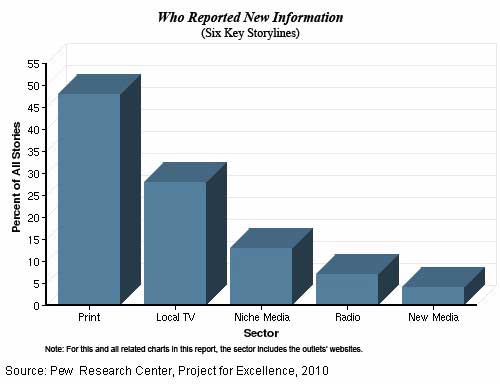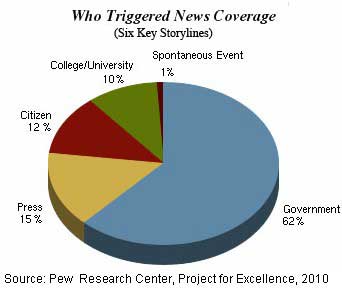Despite the rising prominence of new media, newspapers and other "traditional media" still generate the bulk of original news that gets to US consumers, according to a study by the Pew Research Center.
Moreover, much of the news people receive contains no original reporting: Eight out of ten stories simply repeat or repackage previously reported information, according to the study, which examined all the news outlets that produced local news in Baltimore for one week during 2009.
Of the stories that contained new information, 95% came from traditional media, mostly newspapers.
Below, highlights from the Study of the News Ecosystem of One American City, published by Pew Research Center's Project for Excellence in Journalism.
Among the six major news threads studied––which included stories about budgets, crime, a plan involving transit buses, and the sale of a local theater––83% of stories were essentially repetitive, conveying no new information.
Of the 17% that did contain new information, nearly all came from traditional media, either via their legacy platforms or in new digital ones:
- General-interest newspapers such as the Baltimore Sun produced 48%.
- Local television stations and their websites accounted for 28%.
- Specialty (print) newspapers focused on business and law produced another 13%.

Limited Local Role for Blogs, Multi-Platform Operations
Most of the newer news providers in Baltimore, including blogs and those that use social media such as Twitter, were found to produce no local content during the period studied. Instead, they serve as an alert system and a way to disseminate stories from other places.
A total of 53 news outlets were identified that regularly produce some kind of local news content, ranging from blogs to talk radio to news sites created by former journalists. However, 12 of those outlets did not produce any local content during the days studied.
Looking for real, hard data that can help you match social media tools and tactics to your marketing goals? The State of Social Media Marketing, a 240-page original research report from MarketingProfs, gives you the inside scoop on how 5,140 marketing pros are using social media to create winning campaigns, measure ROI, and reach audiences in new and exciting ways.
Social Media and Web Prominent in Breaking News
New technology is far more prevalent as a way for media––both traditional and new––to break news more quickly. The Web is now clearly the first place of publication for major stories.
During the week studied, there were two cases of new media's breaking information about stories. One came from the police Twitter feed in Baltimore, an example of a newsmaker breaking news directly to the public rather than through the press.
Another was a story noticed by a local blog; the mainstream press nearly missed it entirely, involving a plan by the state to put listening devices on buses to deter crime. A newspaper reporter noticed the blog and then reported the story, which led the state to rescind the plan.
Who Generates Original News?
The US government generates the bulk of original news: In the examination of the six story lines, 62% of stories were initiated by government officials, led by the police. Another 15% came from the press, while interest groups made up the balance.

About the data: The News Ecosystem of One American City study was conducted by the Pew Research Center's Project for Excellence in Journalism and examined all the outlets that produced local news in Baltimore, Maryland, during the week of July 19-25, 2009.



